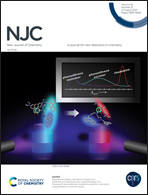Cholinergic drugs bind at the minor groove and reverse induced oxidative stress of calf thymus DNA: a new perspective towards an unexplored therapeutic efficacy†
Abstract
Conformational alterations in the structure of deoxyribonucleic acid (DNA) due to oxidative stress in the DNA backbone are known to be at the root of many life-threatening diseases. A clear comprehension of the interactions between therapeutic drugs and DNA is essential to quantify the possibility of any alterations in DNA that might take place during the administration of these drugs. Herein, the interactions of four FDA approved drugs used in the treatment of Alzheimer's disease (AD), namely donepezil (DON), tacrine (TAC), eserine (ESE) and (−)huperzine (HuPA), with calf thymus DNA (ct-DNA) were investigated through several in vitro spectroscopic, PCR based assay (with plasmid DNA) and molecular modelling experiments. All the four drugs exhibited moderate binding at the minor groove of ct-DNA base pairs, thus, ruling out the possibility of any damage to DNA. The well-established role of reactive oxygen species (ROS) in the aetiology of AD and the known antioxidant properties of the drugs led us to investigate their action in reversing the peroxide induced oxidative stress in DNA. Interestingly, DON was observed to be highly efficient in repairing the oxidative damage in DNA. These inferences have provided an optimistic curative outlook towards the possibility of dual therapeutic action of these drugs.



 Please wait while we load your content...
Please wait while we load your content...